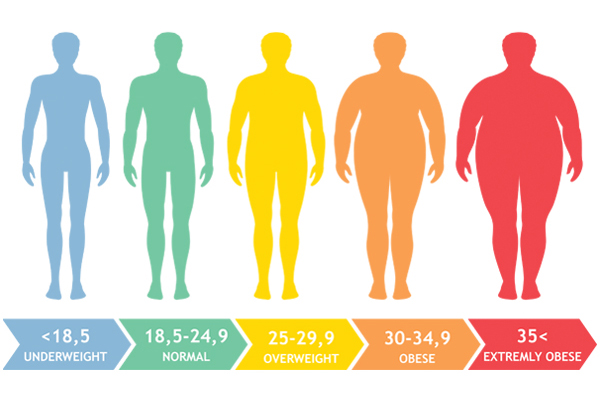What Is a Healthy Weight for Me?

If you’re wondering if there’s a definitive “healthy weight,” here’s the truth: There’s no perfect, absolute number you should aspire to achieve.
Your healthy weight depends on a number of different factors, and there’s no way we can all fit into the same mold.
With that said, everyone has a healthy weight — or better yet, a healthy weight range — they can strive for to limit their risk of weight-related health issues. Here’s how to estimate yours.
How to Find Your Healthy Weight
Age, height, gender, bone density, muscle-to-fat ratio, and overall health can all influence how much you weigh.
While there’s no cut-and-dried formula for calculating your healthy weight, there are four common metrics that medical professionals use:
- Body mass index (BMI)
- Waist-to-hip ratio
- Absolute waist circumference
- Body fat percentage
While these measurements won’t provide you with a magical number to aim for, they can be used as a guideline to determine a healthy weight range.
(Though, again, this isn’t an exact science — it’s also important to pay attention to other factors, like your energy levels, how your clothes fit, and how good you feel overall.)
What Is Body Mass Index (BMI)?

Body Mass Index (BMI) is an estimation of body fat based on a person’s weight and height.
Doctors may use your BMI as a screening tool to determine if you’re at risk for developing obesity-related health problems such as heart disease, high blood pressure, type 2 diabetes, and sleep apnea.
To calculate your BMI, divide your weight in pounds by your height in inches squared, and multiply the result by 703. (Or just use an online BMI calculator.)
The resulting number predicts where you sit on the weight spectrum:
- Underweight = BMI <18.5
- Normal weight = BMI 18.5–24.9
- Overweight = BMI 25–29.9
- Obesity = BMI of 30 or greater
You can get an idea of your recommended weight range for your height by consulting this BMI chart from the National Institutes of Health.
However, the Center for Disease Control and Prevention (CDC) notes that BMI is not a reliable method of measuring body composition, which is all-important, because it only measures “excess weight” and not excess fat.
Excess weight isn’t always a bad thing. Someone who carries a lot of muscle, for example, may have a high BMI even though their body fat percentage is quite low.
That’s why it’s important to take other metrics, like waist circumference and boy fat percentage, into consideration, too.
What Is Absolute Waist Circumference?

Absolute waist circumference is a fancy term for your waist measurement in inches. This measurement should be taken an inch or so above your belly button, says nutrition scientist Eric Feigl-Ding, PhD.
“People with apple-shaped bodies — or a large amount of fat around the midsection — have high risk levels for health problems, especially when their waist circumference is more than 35 inches (for women) or 40 inches (for men),” he explains.
How can this info help you determine your healthy weight? In general, if your waist circumference falls below that threshold, it’s likely that your weight is within a healthy range.
What Is Hip-to-Waist Ratio?
Like BMI and absolute waist circumference, measuring your hip-to-waist ratio is another quick way to estimate whether you’re at a healthy weight.
To calculate hip-to-waist ratio, simply divide your waist measurement (in inches) by your hip measurement (taken at the widest part of your buttocks—also in inches).
The resulting number can be used to predict your risk of developing health conditions such as heart disease, especially in women.
For men, waist-to-hip ratios of:
- Less than 0.9 = low risk
- 0.9 to 0.99 = moderate risk
- 1 or above = high risk
For women, ratios of:
- Less than 0.8 = low risk
- 0.8 to 0.89 = moderate risk
- 0.9 or above = high risk
Similar to BMI, lowering your waist-to-hip ratio into the “low risk” range means that your weight is likely in — or close to — a healthy range.
What Is Body Fat Percentage?

We get it: When you’re trying to lose weight, you want to see the number on the scale go down.
But water retention, muscle mass, and hormones can cause the scale to fluctuate — so focusing on weight isn’t the best way to gauge whether your healthy lifestyle is paying off.
By keeping track of your body fat percentage, however, you can get an idea of how much fat you’ve lost — even if the number on the scale isn’t budging.
And research suggests that body fat percentage — the percentage of your weight that comes from fat — may be a better predictor of cardiovascular risk factors than BMI.
So how do you measure body fat percentage? The most reliable methods include a DEXA (x-ray) scan, underwater weighing, or bioelectrical impedance.
Some of these methods can be done at home — you can shop online for a body fat scale that uses bioelectrical impedance — but for the most accurate estimate of your body fat percentage, you’ll want to let a professional do the measuring (ask your doctor for a recommendation).
Finding Your Healthy Weight Without Crunching Numbers
When it comes to determining and achieving your goal weight, some of the most important variables can’t be calculated or measured.
Take stock of how you feel overall: Do you have enough energy to be as active as you’d like throughout the day? Does your annual physical show you’re in good health? Are you eating and sleeping well?
Pay attention to that instead of solely focusing on what you see on the scale.
“It’s always about a better weight, not a perfect weight,” says Marty Davey, M.S., R.D. “Aiming for better weight is much more useful, because it’s achievable. A 280-pound person who loses even 10 percent of their weight is still obese, but has reduced health risks. That’s a win.”
